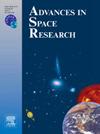Effect of the ocean tide on the Earth nutation: An updated assessment
IF 2.8
3区 地球科学
Q2 ASTRONOMY & ASTROPHYSICS
引用次数: 0
Abstract
Ocean tides perturb the nutation of the Earth rotation axis to a level of 2 mas, an order of magnitude that is 20 times that of the uncertainty of nutation estimations. Ocean tidal effects on nutation represent about 5% of the effects caused by the non-rigidity of the Earth. Therefore, it is of fundamental importance for the development of the nutation theory of a real Earth, in particular for determining the frequencies of the normal modes due to the presence of the fluid outer core and solid inner core. The last published estimates date back to the 2000s. They were obtained by (Mathews et al., 2002) in the frame of the building of the non-rigid Earth nutation model “MHB2000”, which was adopted as the standard in astronomy and geodesy by IAU in 2000. This study aims at reassessing those effects by considering more recent ocean tidal models, namely FES 2014, TPXO8 and EOT11. It extends the computation of the diurnal and semi-diurnal ocean tidal contributions on polar motion and UT1 recently done by (Bizouard and Cheng, 2024) using the principal waves of the ocean tidal angular momentum derived from the models mentioned before. We take into account the recent development of Earth rotation theory, especially the frequency dependence of the transfer functions in sub-diurnal bands. We find not only significant corrections to the terms evaluated by MHB2000 – up to 100 as –, but also significant contributions for circular terms with periods of days, days, days, days, and years. The modelled day term with an amplitude of 60 as is clearly reflected in the celestial pole offsets (CPO) with the same phase and one third of the predicted amplitude. Moreover, the 16 largest in-phase or out-phase perturbations produced by ocean tides, which were not taken into account in the reference model MHB2000, are found in the CPO time series with a systematically smaller amplitude. These results strongly suggest that the current nutation model needs to be revised.
求助全文
约1分钟内获得全文
求助全文
来源期刊

Advances in Space Research
地学天文-地球科学综合
CiteScore
5.20
自引率
11.50%
发文量
800
审稿时长
5.8 months
期刊介绍:
The COSPAR publication Advances in Space Research (ASR) is an open journal covering all areas of space research including: space studies of the Earth''s surface, meteorology, climate, the Earth-Moon system, planets and small bodies of the solar system, upper atmospheres, ionospheres and magnetospheres of the Earth and planets including reference atmospheres, space plasmas in the solar system, astrophysics from space, materials sciences in space, fundamental physics in space, space debris, space weather, Earth observations of space phenomena, etc.
NB: Please note that manuscripts related to life sciences as related to space are no more accepted for submission to Advances in Space Research. Such manuscripts should now be submitted to the new COSPAR Journal Life Sciences in Space Research (LSSR).
All submissions are reviewed by two scientists in the field. COSPAR is an interdisciplinary scientific organization concerned with the progress of space research on an international scale. Operating under the rules of ICSU, COSPAR ignores political considerations and considers all questions solely from the scientific viewpoint.
 求助内容:
求助内容: 应助结果提醒方式:
应助结果提醒方式:


